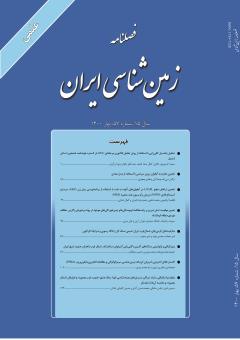بایواستراتیگرافی سازند تیرگان در برشهای چینهشناسی ناویا-رباط عشق (جنوب غرب بجنورد) و قزلقان (شمال بجنورد) و مقایسه آنها با یکدیگر
محورهای موضوعی :نسیم ریاحی 1 , عباس صادقی 2 * , محمدحسین آدابی 3 , حسین کامیابی شادان 4
1 - دانشکده علوم زمین، دانشگاه شهید بهشتی
2 - دانشکده علوم زمین، دانشگاه شهیدبهشتی
3 - دانشکده علوم زمین، دانشگاه شهیدبهشتی
4 - مدیریت اکتشاف شرکت ملی نفت ملی ایران
کلید واژه: بایواستراتیگرافی, سازند تیرگان, ناویا-رباط عشق, قزلقان, بجنورد, کپه داغ غربی,
چکیده مقاله :
بهمنظور مطالعات بایواستراتیگرافی سازند تیرگان در ناحیه کپهداغ غربی، دو برش چینهشناسی سطحالارضی ناویا – رباط عشق در جنوب غرب بجنورد و قزلقان در شمال بجنورد انتخاب و 230 نمونه برداشت شد. ضخامت سازند تیرگان در دو برش ناویا – رباط عشق و قزلقان بهترتیب 237 و 192 متر است و از لحاظ لیتولوژی بهطور عمده از سنگآهک ضخیملایه تا گاه متوسط لایه بهرنگ خاکستری تا کرم تشکیل شده است. مرز زیرین آن در برش ناویا – رباط عشق با سازند زرد – شوریجه همشیب و همراه با تغییرات لیتولوژی واضح است اما در برش قزلقان بهدلیل قرارگیری در هسته تاقدیس نامشخص است. مرز بالایی در برش ناویا-رباط عشق با سازند آبدراز ناپیوستگی فرسایشی و در برش چینهشناسی قزلقان با سازند سرچشمه همشیب و پیوسته است. در مطالعات بایواستراتیگرافی ضمن تشخیص 58 گونه متعلق به 68 جنس از فرامینیفرها، دو بایوزون زیر شناسایی شده است. 1. Palorbitolina lenticularis Taxon Range Zone 2. Novalesia producta – Orbitolina spp. assemblage zone بر اساس بایوزونهای مذکور سن سازند تیرگان در هر دو برش مورد مطالعه بارمین – آپسین پیشین تعیین شده است. مقایسه سازند تیرگان در دو برش قزلقان و ناویا-رباط عشق تفاوتهایی را با یکدیگر نشان میدهد اما از لحاظ بایواستراتیگرافی بهجز اختلاف ضخامت در بایوزونها، تفاوت قابلتوجهی با یکدیگر ندارند.
In order to study biostratigraphy of the Tirgan Formation in western Kopet Dagh, two surface sections including Navia – Robat Eshgh and Ghezelghan, were selected and 230 samples were collected. The Tirgan Formation was measured with a total thickness of 237 and 192 meters in Navia and Ghezelghan sections respectively and was represented by thick and sometimes medium bedded, grey and weathered cream colored limestones in two localities. In Navia section, the Tirgan Formation conformably overlies the Zard – Shurijeh Formation with sharp lithological changes. However, as a result of being located in the core of an anticline, this boundary is not determined in Ghezelghan section. The Tirgan Formation disconformably underlies the Abderaz Formation in Navia section while conformably underlies the Sarcheshme Formation at Ghezelghan section. As a result of biostratigraphical investigations, 58 species belonging to 68 genera of foraminifera were identified in the Tirgan Formation. Based on benthic foraminifera two biozones were determined as follows: 1. Palorbitolina lenticularis Taxon Range Zone 2. Novalesia producta – Orbitolina spp. assemblage zone According to the determined biozones and fossils associations, the age of the Tirgan Formation is Barremian – Early Aptian in both sections. The comparison of the Tirgan Formation, in two-mentioned sections, shows some differences. In terms of biostratigraphy, there is not any significant distinctions, except for thickness difference in biozones.
افشارحرب، ع.، 1373. زمین شناسی کپهداغ. طرح تدوین کتاب زمینشناسی ایران، سازمان زمینشناسی کشور، 11/275.
پایگاه اینترنتی سازمان نقشه برداری کشور، آرشیو نقشه های موضوعی، پهنه کپهداغ، از نقشه وزارت راه و ترابری با مقیاس 1:250000، 1387: (http://www.ncc.gov.ir).
جمالی، ا.م، 1390. بایواستراتیگرافی و لیتواستراتیگرافی نهشتههای کرتاسه زیرین در شرق کپهداغ، پایاننامه دکتری، دانشگاه شهید بهشتی، 446.
خسروتهرانی، خ.، 1395. چینهشناسی ایران. موسسه چاپ و انتشارات دانشگاه تهران، 4، 582.
عباسی، ف.، صادقی، ع.، حسینیبرزی، م. و موسویان، م.، 1392. بایوستراتیگرافی سازند تیرگان در برش چینهشناسی مسینو، غرب کپهداغ، مجله پژوهشهای دانش زمین، 4; 14، 108-95.
Cherchi, A., and Schroeder, R., 2013. The Praeorbitolina/Palorbitolinoides Association: an Aptian biostratigraphic key-interval at the southern margin of the Neo-Tethys. Cretaceous Research, 39, 70-77.
Hardenbol, J., and Vail, P. R., P. R., 1988, Mesozoic and Cenozoic chronostratigraphy and cycles of sea-level change, in Wilgus, C. K., Kendall, C. G. St. C., Posamentier, H. W., Ross, C. A., and Van Wagoner, J. C., eds., Sea Level Changes- An Integrated Approach: Tulsa, Society of Economic Paleontologists and Mineralogists Special Publication 42, p. 71-108.
Henson, F. R. S. 1948. Larger imperforate foraminifera of southwestern Asia. Families Lituolidae, Orbitolinidae and Meandropsinidae. British Museum (Nat. Hist.), London. xi, 585-670.
Hottinger, L. (1967): Foraminifères imperforés du Mésozoïque marocain.– Notes Mém. Serv. géol. Maroc, 209, 1–168.
Husinec, A., Velić, I., Fucek, L., Vlahović, I., Matičec, D., Ostrić, N., & Korbar, T., 2000. Mid Cretaceous orbitolinid (Foraminiferida) record from the islands of Cres and Losinj (Croatia) and its regional stratigraphic correlation. Cretaceous Research, 21(1), 155-171.
Kalantari, A.,1969. Foraminifera from the middle Jurassic-Cretaceous successions of Koppet-Dagh region (NE Iran). National Iranian Oil Company, Geological Laboratories Publ 3:1-298.
Loeblich Jr., A.R., Tappan, H., 1988. Foraminiferal genera and their classification (2 volumes). Van Nostrand Reinhold, New York, 970
Schroeder, R., van Buchem, F. S., Cherchi, A., Baghbani, D., Vincent, B., Immenhauser, A., and Granier, B., 2010. Revised orbitolinid biostratigraphic zonation for the Barremian–Aptian of the eastern Arabian Plate and implications for regional stratigraphic correlations. GeoArabia Special Publication, 4(1), 49-96.
Schroeder, R.,1965. Dictyoconus pachymarginalis n. sp. aus dem Apt des Elburz-Gebirges (Nord-
Iran)(Studien über primitive Orbitolinidae III). Eclogae Geologicae Helvetiae, 58(2), 976-979.Vanneau, A. A., and Silva, I. P.,1995. 10. Biostratigraphy and Systematic Description Of Benthic Foraminifers From Mid-Cretaceous Shallow-Water Carbonate Platform Sediments At Sites 878 and 879.
Vanneau, A.A., 1980. Micropaléontologie, paléoécologie, et sédimentologie d'une plate-forme carbonatée de la marge passive de la Téthys: l'Urgonien du Vercors septentrional et de la Chartreuse (Alpes occidentales) (Doctoral dissertation, Universite Scientifique et Medicale de Grenoble), 267
Velic, I. ,1988. Lower Cretaceous benthic foraminiferal biostratigraphy of the shallow-water carbonates of the Dinarides. Revue de Paléobiologie, Volume Spécial, 2, 467-475.
Vilas, L., Masse, J. P., and Arias, C. ,1995. Orbitolina episodes in carbonate platform evolution: the early Aptian model from SE Spain. Palaeogeography, Palaeoclimatology, Palaeoecology, 119 (1-2), 35-45.

